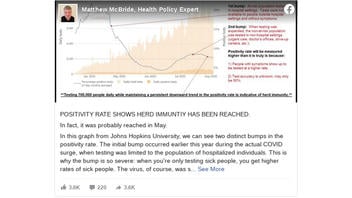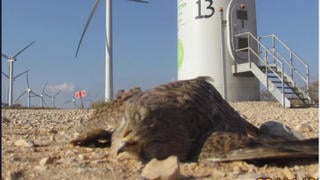
Would a drop in the percent of positive tests for COVID-19 prove the U.S. has reached "herd immunity"? No, that's not true: The doctor overseeing the testing lab at the pandemic's ground zero says so-called 'positivity' data is not an indicator of herd immunity.
Increasing numbers of COVID cases in Florida and Arizona at the time the claim was made show the disease still spreading, which would not happen if herd immunity had been accomplished, said a University of Arizona College of Medicine public health professor.
The claim appeared in a Facebook post (archived here) on August 4, 2020 under the title 'POSITIVITY RATE SHOWS HERD IMMUNTIY(sic) HAS BEEN REACHED'. It opened:
In fact, it was probably reached in May.
This is what the post looked like on Facebook at the time of writing:
(Source: Facebook screenshot taken on Fri Aug 7 18:43:56 2020 UTC)
Dr. Geoffery Baird, of the University of Washington in Seattle, site of the first major U.S. outbreak said in an August 7, 2020 phone interview with Lead Stories:
You actually do not assess herd immunity based on the kinetics of infections and positivity rates. You assess herd immunity by assessing herd immunity, which we've done, and it's not there.
Baird said the labs he supervises are processing up to 8,000 tests per day and working with other labs across the country, studying the spread of COVID-19 and the effect of various efforts to stop the spread.
Is there herd immunity in the U.S.?
'Absolutely not,' said Dr. Farshad Marvasti, Director of the Public Health, Prevention and Health Promotion curriculum University of Arizona College of Medicine. 'If we had, there would not be hosts for this virus,' yet the number of cases was rising in several U.S. states, he said in an August 7, 2020 phone interview with Lead Stories. Marvasti said the growing number of infections in Arizona, for example, showed there is 'no validity' to the claim that enough Americans are now immune that the disease can no longer spread.
Claim made by IT contractor
Contradicting board-certified epidemiologists with medical degrees and PhDs operating independently of one another at multiple universities and public health agencies across the U.S., self-described "Health Policy Expert" Matthew McBride declared 'herd immunity has been reached and the virus is dying out." He said politicians are lying about the disease in order to extend government shutdowns and mask-wearing requirements for political reasons.
Though no profile photo confirms it's the same person, James McBride on LinkedIn(tm), lists his expertise as 'Payment and Reimbursement Expert. Lead Stories reached out to McBride to confirm his credentials and will update this report, if appropriate, when he replies.
In an email exchange with Lead Stories on August 7, 2020, Walden University, an online school, confirmed that between 2007 and 2015, Walden granted a diploma to a Matthew McBride for a Masters of Science in Health Informatics, which is the management of computer systems for storage and retrieval of health records. The school also confirmed it granted him a diploma for a Masters in Public Health. McBride's resume lists his current job as consultant on payment and reimbursement systems for the U.S. Department of Veterans Affairs. Lead Stories reached out to the V.A. to confirm that and will update this report, if appropriate, when the agency replies.
Herd immunity tests not encouraging
The Seattle testing expert, Dr. Baird, earned his M.D. and Ph.D. from University of California/ San Diego and is board-certified in Anatomic Pathology, Clinical Pathology and Clinical Chemistry. He said there are multiple sets of serology tests - which show if a person has been exposed - and that even in New York City, which had a major outbreak, only about 20 percent of those tested had been exposed to the disease. 'We're nowhere near the 70-90% that is required for herd immunity,' Baird said in an August 7, 2020 phone interview with Lead Stories.
Defining herd immunity
When a large enough portion of a community becomes immune to a disease through vaccination or by surviving infection, the disease is less able to jump from person to person, which is what epidemiology and public health experts call herd immunity.
Mayo Clinic public education materials say the more contagious a disease is, the greater the proportion of the population that needs to be immune to break the chain of transmission. If most of the people exposed to a disease are immune, it dies out.
Depending how contagious an infection is, between 70% to 90% of a population must be immune to prevent community spread of the disease, say COVID-19 information sheets provided by the Johns Hopkins University School of Public Health. Based on early estimates of the degree of infectiousness of this disease, herd immunity will require an immunity rate of about 70%, the Johns Hopkins materials say.
The only way the U.S. will achieve herd immunity in 2020 is if there is a catastrophic failure of the public health system, say two epidemiology experts at the Johns Hopkins University Bloomberg School of Public Health.
Other claims
Among the other claims made on McBride's posting:
In this graph from Johns Hopkins University, we can see two distinct bumps in the positivity rate. The initial bump occurred earlier this year during the actual COVID surge, when testing was limited to the population of hospitalized individuals...In June, testing became more widely available, meaning people who had milder symptoms were now being added to the counts. Important: This second bump includes the wider population of at-risk people (tested in hospitals) and non-at-risk people (tested outside hospitals). It's basically reflective of the population...
Dr. Marvasti said that assumption is incorrect. 'It really hasn't shifted the way he is claiming. That's not really true, because the people being tested in a situation where you don't have enough tests are still the people who are sick." Marvasti formerly worked for a county public health agency, was a postdoctoral research fellow at the Stanford University Prevention Research Center and serves on the Public Health Committee of the Arizona Medical Association. He said McBride has assumed the first wave of infection was suppressed. Marvasti said the U.S. has not depressed infection rates enough to be in the second wave of infection that is a common feature of epidemics.
We haven't finished the first wave yet. We got a bit of a trough, but we didn't actually go down. We just decreased a little bit and then went soaring back up.This curve that he includes here, the decrease that you saw? It basically proves the point that lockdown worked and then we opened too quick. And the reason why it's not as big of a bump is because not everybody was dumb enough to open up too quickly. Not everybody jumped the gun...and mistakenly opened up everything without mask wearing.
McBride, who is not a biostatistician, said the following about the data chart he wrote notes on and posted with his claim about herd immunity. The chart is from the COVID-19 information site operated by Johns Hopkins University School of Public Health. Illogically, McBride both claims the test are inaccurate and uses the data from those tests as the basis for his declaration the COVID-19 pandemic has passed through the U.S. population.
Ask any biostatistican what it means when you test hundreds of thousands of people a day for an infectious disease and return a consistently lowering positivity rate. I'll give you a clue: it means heard (sic) immunity has been reached and the virus is dying out...it's clear from the first bump's drastic reduction in positivity at the beginning of May that the virus has largely moved through the at-risk population, and COVID is now petering out.
Marvasti said the data McBride points to show the opposite. 'We don't have a consistently lowering positive rate,' he said, describing the rate of positive tests as fluctuating up and down. Marvasti said those changes in the curve are the result of the changes in mask-wearing rules and business closures from state to state,which result in new outbreaks such as those in Arizona and Florida.The curve McBride points to, Marvasti said, proves that lockdowns and mask-wearing work.
The decrease was due to lockdowns. The increases are because we opened up too quickly and too much. That's what we got. It's not petering out.
Lead Stories has debunked multiple false or misleading claims about the meaning of COVID-19 test data, including the following:
















